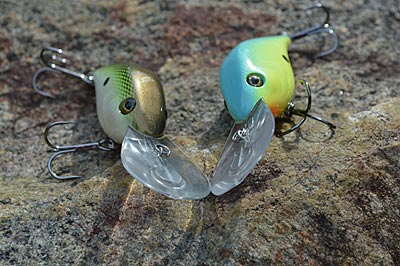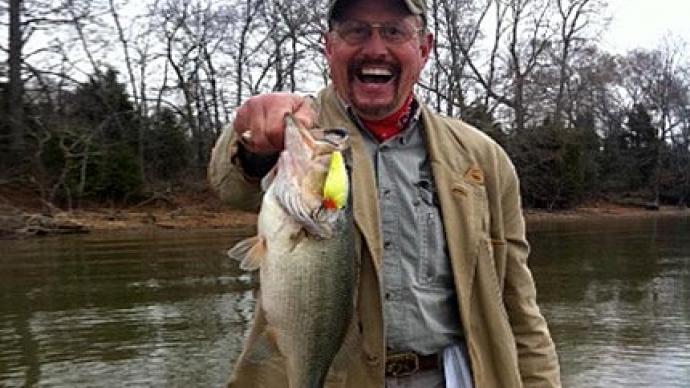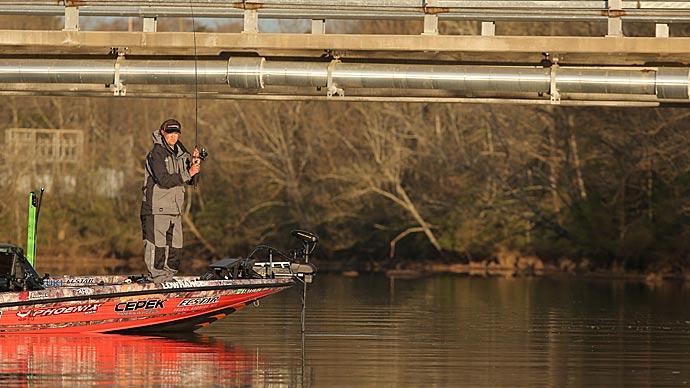
Any time of the year is an excellent time to tie on a crankbait. I think first of crankbaits when I'm trying to locate fish. Whether on a new lake or just the ones near my home where I fish regularly, these lures will help you find fish.
Crankbaits can be used to cover water until fish are located, then other baits such as jigs and worms will be used to finish out limits. If you keep up with the pros, you'll notice them referring to a crankbait as the bait they used to locate their fish.
Cranks work well on a tree line or creek channel. Usually, when you turn back down that area and work it slower, you can catch bass that wouldn't chase after faster-moving baits.
There are four basic styles of crankbaits available. There are many brands, but the essential baits you want are lipless cranks, shallow runners, medium runners, and deep divers.
Several companies make lipless crankbaits. Bill Lewis Lures make the one I prefer. It is the Rat-L-Trap, and this bait has rattles in it that drive fish crazy. It's one bait that will catch just about any species of fish you might be after.
Popular sizes are ¼-, ½-, and ¾-ounce, with the ½-ounce being the most widely used by anglers. However, the company came out with a new 1-ounce model recently, and has already proven to be an excellent big bass lure.
The ¾-ounce and 1-ounce sizes in red dog, red shad, and chrome/blue back are good colors at any lake.
You should try to choose the size of your lure according to the size of baitfish in the lake and cover shallow water with structure. Bass will attack this bait from stumps or grass lines. Along the edges of aquatic grassbeds are good places to use lipless cranks to locate fish. Sometimes the largest fish of the day will be caught in this manner.
Experiment with your retrieve. Try ticking the tops of submerged grass beds. Bass will explode with a vengeance on a Rat-L-Trap fished this way. This bait is my first choice when bass are schooling. When using lipless cranks, I prefer a 7 foot 3-inch medium-action casting rod over open water and fast action in heavy cover. I also use a 6 to 1 ratio Abu Garcia reel to do the job with a slow or fast retrieve.
With all the crankbaits on the market, I usually find myself using ones made of wood. For shallow-running cranks, my choices are made by Poe's. These baits are made of cedar and are very light. The 1100, 1100R (rattle), and 1100ss (same body size with a wider bill) all run four to 10 feet deep.
Wood baits seem to produce a natural swimming action. The RC1 and RC3 both have flat sides and a squared lip that gives an erratic deflect, like a disoriented fish.
Shallow-running crankbaits are mainly used in shallow water, but they can also become effective when bass are suspended in structure in deeper water.
I like a 7-1/2 foot light to medium action power casting rod with a fast-action tip for these lures. The best results can be achieved with a 12- to 14-pound test line and an ABU Garcia baitcasting reel. You can down-size the line to 8- to 10-pound test using ABU Garcia's spinning reel. This will help you achieve more significant action and depth.
Some of the medium-depth runners are Bomber Model 7As and Norman's NXS. I also like the Poe's 300 in crawfish colors around the new and full moons. The rest of the month, I like a shad pattern.
The best way to use crankbaits that dive to medium depths is to bounce them off stumps or the bottom or run them along the edges of shallow grass. Baits with narrow lips and thin sides have a tight, fast wiggle, while baits with a broad lip will produce a wider, slower wiggle.
The best rod to run these baits with will be one specially made for crankbaits like the All Star Classic Graphite 7-1/2-foot crankin' stick with fast tip action and medium power. Use 14-pound test line to get the best from these baits. Stren is my choice.
There are many choices of baits that run deep. There are Poe's 400 and 400 Plus, Norman's DD22, Mann's Deep 20+ and 30+, Bomber Fat A, Mud Bugs, and many more.
These are the sizes of baits I prefer to use to locate fish. These big-lipped baits should be run down to their maximum running depth, then slowed to a crawl. They do their best when fished over submerged trees or when you're dredging the bottom.
Deep divers will also be productive around or on top of grass. Most of the time, you'll find me throwing a Poe's 400 in 10 to 14 feet of water early in the day. Then, I'll fish the same bait later in the day at 30 feet. This is where you'll catch that hard-to-get bite from fish suspended in treetops.
The larger lips on deep divers will allow you to run them through tree tips without many hang-ups. When you feel the brush, you can slow down your retrieve, and the bait will flip over the limb. You can feel that the bait then begins to dive once more. Often this is when the bass will hit the lure.
I prefer heavy line for these baits and always use at least 20- 25-pound test. You'll also need a medium power casting rod with a fast tip to get the most out of these lures.
It's not uncommon for me to have three or four rods in my boat with crankbaits tied on them year around. It's also not uncommon for me to fish with a deep-diver all day. Then, if the fish bite it, I'll throw it.
If you don't throw crankbaits as often as you should because you think they'll hang up easily or you'll lose them, don't worry. Most crankbaits can be retrieved. The most important thing is don't continue to pull on it once it becomes snagged. This only digs the hooks in deeper. Instead, place your boat straight above or past your target snag spot and try to shake it loose. Sometimes you can thump your line like a bow with your thumb and index finger, and the bait will pop loose. Some people have become very skilled with this and lost a few crankbaits.
If you don't choose to fish crankbaits, you pass up some exciting fishing trips when nothing else will work.
BassResource may receive a portion of revenues if you make a purchase using a link above.




